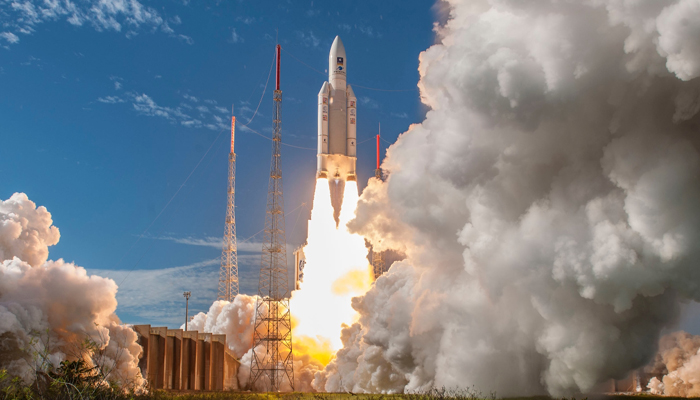TRENDING TAGS :
India's communication satellite GSAT-31 launched successfully
Indian Space Research Organisation’s (ISRO) Satish Dhawan Space Centre (SDSC) Director S. Pandian expressed his pleasure on the successful launch of GSAT-31 spacecraft on board Ariane-5, at Kourou soon after the launch.
Bengaluru: The company will be streaming the event live on YouTube and on the dedicated Flipkart microsite. You can also watch the live stream right here. India's communication satellite GSAT-31 launched successfully.
Bengaluru: India added another feather in its cap by an unprecedented success in the space mission. India’s latest communication satellite GSAT-31 was successfully launched by European launch services provider- Arianespace’s rocket from French Guiana, on Wednesday morning.
ALSO READ: US SC contender Neomi faces scrutiny for her views on rape victims
Blasting off from Ariane Launch Complex at Kourou, a French territory located in northeastern coast of South America at at 2.31 am (IST), the Ariane-5 vehicle injected GSAT-31 into the orbit in a flawless flight lasting about 42 minutes.
Indian Space Research Organisation’s (ISRO) Satish Dhawan Space Centre (SDSC) Director S. Pandian expressed his pleasure on the successful launch of GSAT-31 spacecraft on board Ariane-5, at Kourou soon after the launch.
He also congratulated Arianespace on the successful launch and precise injection of satellite into the orbit.
The GSAT-31 is a “high power” communication satellite with Ku-band, and it is going to serve and replace some of the satellites that are going to expire soon, said Pandian.
Weighing about 2,536 kg, the Indian satellite, GSAT-31, will provide continuity to operational services on some of the in-orbit satellites.
ALSO READ: ED says banks can sell Mallya’s assets to recover their money
The Ariane-5 vehicle (Flight VA247) also carried Saudi Geostationary Satellite 1/Hellas Sat 4 along with GSAT-31.
GSAT-31 separated from the Ariane-5 in an elliptical Geosynchronous Transfer Orbit with a perigee (nearest point to Earth) of 250 km and an apogee (farthest point to Earth) of 35,850 km, inclined at an angle of 3.0 degree to the equator, ISRO said in a release after the launch.
After separation from Ariane-5, the two solar arrays of GSAT-31 were automatically deployed in quick succession and ISRO’s Master Control Facility at Hassan in Karnataka took over the command and control of GSAT-31 and found its health parameters normal, it said.
In the days ahead, scientists will undertake phase-wise orbit-raising manoeuvres to place the satellite in Geostationary Orbit (36,000 km above the equator) using its on-board propulsion system.
During the final stages of its orbit raising operations, the antenna reflector of GSAT-31 will be deployed, and following this, the satellite will be put in its final orbital configuration, the space agency said, adding that the satellite will be operational after the successful completion of all in-orbit tests.
GSAT-31 is the country’s 40th communication satellite which is configured on ISRO’s enhanced ‘I-2K Bus’, utilising the maximum “bus capabilities” of this type.
This satellite will augment the Ku-band transponder capacity in Geostationary Orbit, ISRO said.
With a mission life of around 15 years, GSAT-31 will be used for supporting VSAT networks, Television uplinks, Digital Satellite News Gathering, DTH-television services, cellular backhaul connectivity and many such applications.
It will also provide wide beam coverage to facilitate communication over large oceanic region, comprising large parts of Arabian Sea, Bay of Bengal and Indian Ocean, using a wide band transponder.
ALSO READ: SC Sabarimala hearing: “Untouchability has nothing to do with custom”
According to ISRO, two Ku-band beacon down link signals are transmitted by the satellite for ground tracking purpose . GSAT-31 has a unique configuration of providing flexible frequency segments and flexible coverage,” ISRO chairman K. Sivan said.
"GSAT-31 will provide DTH Television Services, connectivity to VSATs for ATM, Stock-exchange, Digital Satellite News Gathering (DSNG) and e-governance applications. The satellite will also be used for bulk data transfer for a host of emerging telecommunication applications,” he said in a release.
Pandian also said that ISRO will soon loft GSAT-30 , another geostationary satellite by Arianespace.



